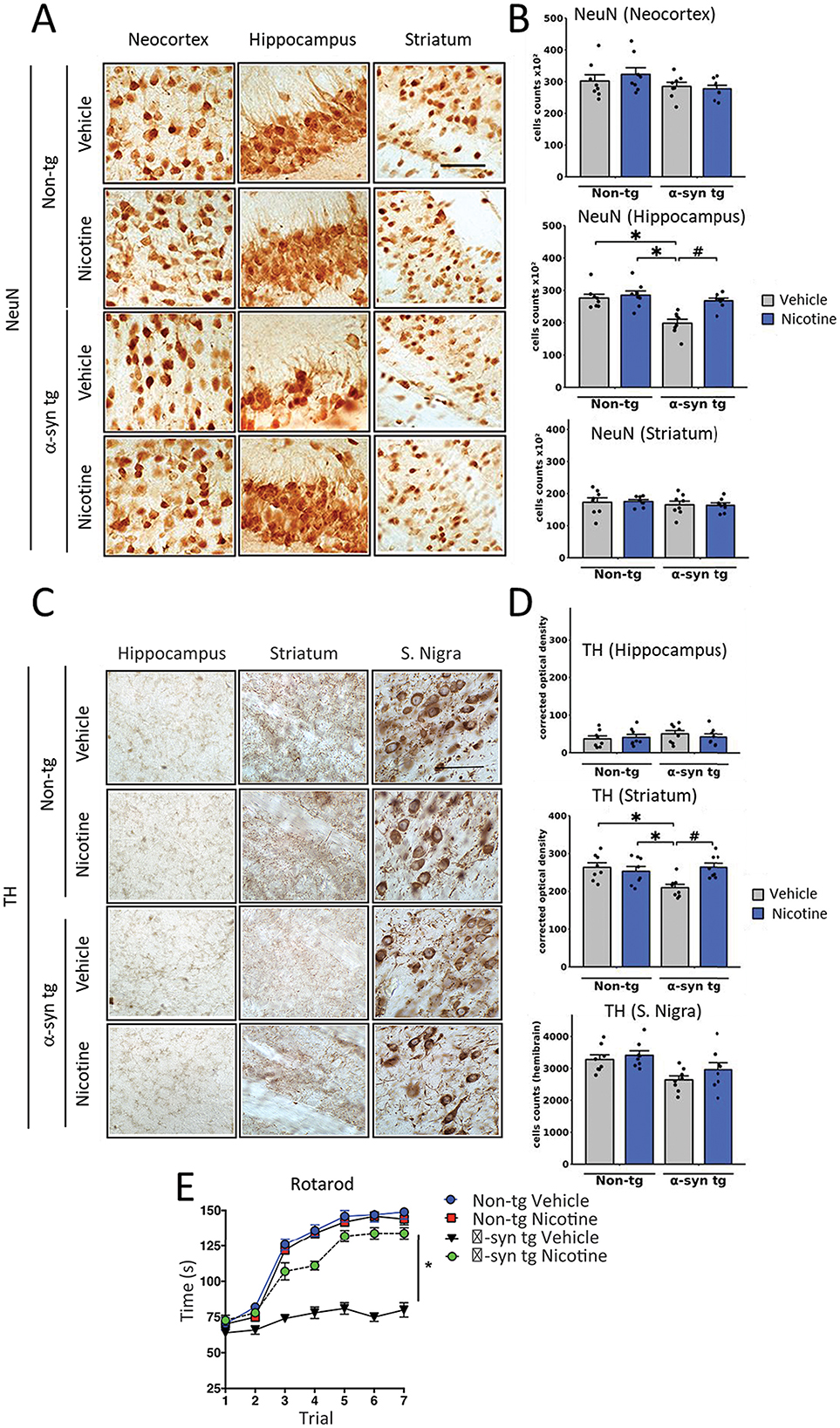- 1PMI R&D, Philip Morris Products S.A., Neuchâtel, Switzerland
- 2Department of Neurosciences, University of California, San Diego, San Diego, CA, United States
A Correction on
Nicotine-mediated effects in neuronal and mouse models of synucleinopathy
by Fares, M. B., Alijevic, O., Johne, S., Overk, C., Hashimoto, M., Kondylis, A., Adame, A., Dulize, R., Peric, D., Nury, C., Battey, J., Guedj, E., Sierro, N., Mc Hugh, D., Rockenstein, E., Kim, C., Rissman, R. A., Hoeng, J., Peitsch, M. C., Masliah, E., and Mathis, C. (2023). Front. Neurosci. 17:1239009. doi: 10.3389/fnins.2023.1239009
In the published article, there was an error in Figure 3C as published whereby micro-repeats appeared in the panel corresponding to the hippocampus of the vehicle non-tg control image. The corrected Figure 3 and its caption appear below.

Figure 3. Effects of nicotine treatment on neurodegeneration and locomotor activity in α-Syn tg mice. Twelve-month-old PDGFβ α-Syn-tg and non-tg mice were treated with nicotine (0.1 mg/kg intraperitoneal [IP]) or saline (= vehicle) twice daily for 2 weeks. Brain sections were immunohistochemically evaluated for neurodegeneration with the neuronal marker NeuN (A, B) and the dopaminergic marker anti-TH (C, D). (A) Representative photomicrographs and (B) quantitation of the number of neurons in the neocortex, hippocampus, and striatum. While the number of NeuN-positive cells was unchanged in the neocortex and striatum, saline-treated α-Syn tg mice had significantly fewer neurons in the hippocampus than saline-treated non-tg mice. Nicotine treatment normalized the number of NeuN-positive cells in the hippocampus of α-Syn tg mice relative to saline-treated α-Syn tg mice. N = 8/group. Scale bar = 50 μm.*p < 0.0001, #p < 0.001. (C) Representative photomicrographs and (D) quantitation of TH immunoreactivity in the substantia nigra (s. nigra), hippocampus, and striatum. While TH immunoreactivity was unchanged in the hippocampus and substantia nigra, saline-treated α-Syn tg mice exhibited significantly less immunoreactivity in the striatum than saline-treated non-tg mice. Nicotine treatment normalized TH immunoreactivity in the striatum of α-Syn tg mice relative to saline-treated α-Syn tg mice. N = 8/group. Scale bar = 50 μm. *p < 0.05, #p < 0.01. (E) The effect of nicotine treatment on locomotor activity was assessed using the rotarod test. Saline-treated α-Syn tg mice spent significantly less time on the rotarod than saline-treated non-tg mice. Nicotine-treated α-Syn tg mice remained on the rotarod for significantly longer than saline-treated α-Syn tg mice *p < 0.05, N = 8 mice/group. In panels (B, D), dots represent individual values and bars denote the mean ± standard error of the mean.
The original article has been updated.
Publisher's note
All claims expressed in this article are solely those of the authors and do not necessarily represent those of their affiliated organizations, or those of the publisher, the editors and the reviewers. Any product that may be evaluated in this article, or claim that may be made by its manufacturer, is not guaranteed or endorsed by the publisher.
Keywords: synucleinopathy, induced pluripotent stem cell (iPSC), transgenic mice, nicotine, nicotinic acetylcholine receptors (nAChR), neuroprotection
Citation: Fares MB, Alijevic O, Johne S, Overk C, Hashimoto M, Kondylis A, Adame A, Dulize R, Peric D, Nury C, Battey J, Guedj E, Sierro N, Mc Hugh D, Rockenstein E, Kim C, Rissman RA, Hoeng J, Peitsch MC, Masliah E and Mathis C (2025) Correction: Nicotine-mediated effects in neuronal and mouse models of synucleinopathy. Front. Neurosci. 19:1662162. doi: 10.3389/fnins.2025.1662162
Received: 08 July 2025; Accepted: 15 July 2025;
Published: 01 August 2025.
Edited and reviewed by: Guo-Yuan Yang, Shanghai Jiao Tong University, China
Copyright © 2025 Fares, Alijevic, Johne, Overk, Hashimoto, Kondylis, Adame, Dulize, Peric, Nury, Battey, Guedj, Sierro, Mc Hugh, Rockenstein, Kim, Rissman, Hoeng, Peitsch, Masliah and Mathis. This is an open-access article distributed under the terms of the Creative Commons Attribution License (CC BY). The use, distribution or reproduction in other forums is permitted, provided the original author(s) and the copyright owner(s) are credited and that the original publication in this journal is cited, in accordance with accepted academic practice. No use, distribution or reproduction is permitted which does not comply with these terms.
*Correspondence: Carole Mathis, Y2Fyb2xlLm1hdGhpc0BwbWkuY29t
†Present addresses: Mohamed Bilal Fares, ND Biosciences, Biopole, Épalinges, Switzerland
Makoto Hashimoto, Laboratory for Parkinson's Disease, Tokyo Metropolitan Institute of Medical Science, Tokyo, Japan
Changyoun Kim and Eliezer Masliah, Laboratory of Neurogenetics, National Institute on Aging, National Institute of Health, Bethesda, MD, United States
 Mohamed Bilal Fares1†
Mohamed Bilal Fares1† Stephanie Johne
Stephanie Johne Cassia Overk
Cassia Overk Catherine Nury
Catherine Nury James Battey
James Battey Emmanuel Guedj
Emmanuel Guedj Robert A. Rissman
Robert A. Rissman Manuel C. Peitsch
Manuel C. Peitsch Eliezer Masliah
Eliezer Masliah Carole Mathis
Carole Mathis